Central Composite Design Optimisation in Single Point Incremental Forming of Truncated Cones from Commercially Pure Titanium Grade 2 Sheet Metals
Abstract
:1. Introduction
- Sheet metal components with higher elongation can be made;
- Increased forming limits can be achieved;
- SPIF technology is more environmentally friendly than SMF methods;
- Surface quality and shape–dimensional accuracy are higher;
- As a die-less technology, SPIF does not require expensive stamping machines;
- It can replace SMF in small batch production.
2. Materials and Methods
2.1. Material
2.2. Experimental Setup
3. Results and Discussion
3.1. Central Composite Design with RSM
3.2. Axial Force Fz
3.3. In-Plane Force Fxy
3.4. Surface Roughness Parameter Rz
3.5. Forming Success h
3.6. Validation Run
4. Conclusions
- The direction of tool rotation in relation to the feed direction is one of the key SPIF parameters influencing the possibility of receiving a Grade 2 titanium drawpiece without the risk of cracking. Drawpieces formed with clockwise tool rotation exhibit higher height without the risk of cracking;
- The direction of spindle rotation significantly affects the formability of Grade 2 titanium sheets, but only at a high speed of rotation of the spindle with an accompanying small step size;
- By increasing spindle speed, a reduction in forming forces was observed;
- Samples formed with high values of spindle speed showed poor surface qualities;
- A major factor affecting forming forces is step size;
- The archived R2 value equals 0.9502, 0.9142, and 0.9077 for the axial forming force, the in-plane forming force, and the surface roughness parameter Rz, respectively, signifying that the second-order polynomial regression models are 95.02%, 91.42%, and 90.77% able to predict the response value;
- The optimal forming parameters minimising the surface roughness and axial and in-plane components of the forming force are as follows: spindle speed −580 rpm, feed rate 2000 mm/min, and step size 0.5 mm;
- The experiments performed with the optimal parameters produced a 2.2%, 1.6%, and 4% discrepancy with the model as regards surface roughness, axial force, and in-plane force, respectively.
Author Contributions
Funding
Institutional Review Board Statement
Informed Consent Statement
Data Availability Statement
Conflicts of Interest
References
- McAnulty, T.; Jeswiet, J.; Doolan, M. Formability in single point incremental forming: A comparative analysis of the state of the art. CIRP J. Manuf. Sci. Technol. 2017, 16, 43–54. [Google Scholar] [CrossRef]
- Sevšek, L.; Pepelnjak, T. The review of the achievements in the field of incremental forming. Res. Sci. Today 2019, 1, 124–135. [Google Scholar]
- Trzepieciński, T. Recent Developments and Trends in Sheet Metal Forming. Metals 2020, 10, 779. [Google Scholar] [CrossRef]
- Li, Y.; Chen, X.; Liu, Z.; Sun, J.; Li, F.; Li, J.; Zhao, G. A review on the recent development of incremental sheet-forming process. Int. J. Adv. Manuf. Technol. 2017, 92, 2439–2462. [Google Scholar] [CrossRef]
- Sbayti, M.; Bahloul, R.; BelHadjSalah, H.; Zemzemi, F. Optimization techniques applied to single point incremental forming process for biomedical application. Int. J. Adv. Manuf. Technol. 2017, 95, 1789–1804. [Google Scholar] [CrossRef]
- Sbayti, M.; Bahloul, R.; BelHadjSalah, H. Efficiency of optimization algorithms on the adjustment of process parameters for geometric accuracy enhancement of denture plate in single point incremental sheet forming. Neural Comput. Appl. 2019, 32, 8829–8846. [Google Scholar] [CrossRef]
- Mahajan, P.; Pal, M.; Kumar, R.; Agrawal, A. Experimental and Simulation Study of Incremental Forming for Titanium Grade 2 Sheet. In Proceedings of the 15th International Manufacturing Science and Engineering Conference ASME Volume 1: Additive Manufacturing; Advanced Materials Manufacturing; Biomanufacturing; Life Cycle Engineering; Manufacturing Equipment and Automation, Online. 3 September 2020; Available online: https://asmedigitalcollection.asme.org/MSEC/proceedings-abstract/MSEC2020/84256/V001T05A009/1095671 (accessed on 15 January 2021).
- Oleksik, V.; Bologa, O.; Breaz, R.; Racz, G. Comparison between the numerical simulations of incremental sheet forming and conventional stretch forming process. Int. J. Mater. Form. 2008, 1, 1187–1190. [Google Scholar] [CrossRef]
- Blaga, A.; Oleksik, V. A Study on the Influence of the Forming Strategy on the Main Strains, Thickness Reduction, and Forces in a Single Point Incremental Forming Process. Adv. Mater. Sci. Eng. 2013, 2013, 1–10. [Google Scholar] [CrossRef] [Green Version]
- Najm, S.M.; Paniti, I. Artificial neural network for modeling and investigating the effects of forming tool characteristics on the accuracy and formability of thin aluminum alloy blanks when using SPIF. Int. J. Adv. Manuf. Technol. 2021, 114, 2591–2615. [Google Scholar] [CrossRef]
- Najm, S.M.; Paniti, I. Study on Effecting Parameters of Flat and Hemispherical end Tools in SPIF of Aluminium Foils. Teh. Vjesn. Tech. Gaz. 2020, 27, 1844–1849. [Google Scholar] [CrossRef]
- Gil Azevedo, N.; Farias, J.S.; Bastos, R.; Teixeira, P.; Davim, J.P.; de Sousa, R.J.A. Lubrication aspects during Single Point Incremental Forming for steel and aluminum materials. Int. J. Precis. Eng. Manuf. 2015, 16, 589–595. [Google Scholar] [CrossRef]
- Trzepiecinski, T.; Fejkiel, T. On the influence of deformation of deep drawing quality steel sheet on surface topography and friction. Tribol. Int. 2017, 115, 78–88. [Google Scholar] [CrossRef]
- Spišák, E.; Majerníková, J.; Kaščák, L.; Mulidran, P. The Impact of Shear Gap Size on the Quality of the Sheared Surface in Electrical Steel Sheet Blanking. Acta Met. Slovaca 2020, 26, 49–53. [Google Scholar] [CrossRef]
- Trzepieciński, T. 3D elasto-plastic FEM analysis of the sheet drawing of anisotropic steel sheet. Arch. Civ. Mech. Eng. 2010, 10, 95–106. [Google Scholar] [CrossRef]
- Petek, A.; Gantar, G.; Pepelnjak, T.; Kuzman, K. Economical and Ecological Aspects of Single Point Incremental Forming Versus Deep Drawing Technology. Key Eng. Mater. 2007, 344, 931–938. [Google Scholar] [CrossRef]
- Trzepiecinski, T.; Lemu, H.G. Recent Developments and Trends in the Friction Testing for Conventional Sheet Metal Forming and Incremental Sheet Forming. Metals 2019, 10, 47. [Google Scholar] [CrossRef] [Green Version]
- Ambrogio, G.; Sgambitterra, E.; De Napoli, L.; Gagliardi, F.; Fragomeni, G.; Piccininni, A.; Gugleilmi, P.; Palumbo, G.; Sorgente, D.; la Barbera, L.; et al. Performances analysis of titanium prostheses manufactured by superplastic forming and incremental forming. Procedia Eng. 2017, 183, 168–173. [Google Scholar] [CrossRef]
- Lu, B.; Ou, H.; Shi, S.Q.; Long, H.; Chen, J. Titanium based cranial reconstruction using incremental sheet forming. Int. J. Mater. Form. 2014, 9, 361–370. [Google Scholar] [CrossRef] [Green Version]
- Racz, S.G.; Breaz, R.E.; Tera, M.; Gîrjob, C.; Biriș, C.; Chicea, A.L.; Bologa, O. Incremental Forming of Titanium Ti6Al4V Alloy for Cranioplasty Plates—Decision-Making Process and Technological Approaches. Metals 2018, 8, 626. [Google Scholar] [CrossRef] [Green Version]
- Peter, I.; Fracchia, E.; Canale, I.; Maiorano, R. Incremental sheet forming for prototyping automotive modules. Procedia Manuf. 2019, 32, 50–58. [Google Scholar] [CrossRef]
- Chauhan, S.R.; Dass, K. Dry Sliding Wear Behaviour of Titanium (Grade 5) Alloy by Using Response Surface Methodology. Adv. Tribol. 2013, 2013, 1–9. [Google Scholar] [CrossRef] [Green Version]
- Rajesh, A.; Varthanan, P.A.; Appasamy, R.; Perumal, A.V. Investigation of fatigue strength of aluminium 2024-T3 subjected to shot peening process by Ni shots. Mater. Res. Express 2020, 7, 016593. [Google Scholar] [CrossRef]
- Bose, S.; Nandi, T. A novel optimization algorithm on surface roughness of WEDM on titanium hybrid composite. Sadhana 2020, 45, 1–10. [Google Scholar] [CrossRef]
- Ajay, C.V. Parameter Optimization in Incremental Forming of Titanium Alloy Material. Trans. Indian Inst. Met. 2020, 73, 2403–2413. [Google Scholar] [CrossRef]
- Saidi, B.; Giraud-Moreau, L.; Cherouat, A. Optimization of the single point incremental forming process for titanium sheets by using response surface. MATEC Web Conf. 2016, 80, 10011. [Google Scholar] [CrossRef]
- Palumbo, G.; Brandizzi, M.; Cervelli, G.; Fracchiolla, M. Investigations about the Single Point Incremental Forming of Anisotropic Titanium Alloy Sheets. Adv. Mater. Res. 2011, 264–265, 188–193. [Google Scholar] [CrossRef]
- Mohanraj, R.; Elangovan, S. Incremental sheet metal forming of Ti–6Al–4V alloy for aerospace application. Trans. Can. Soc. Mech. Eng. 2019, 44, 56–64. [Google Scholar] [CrossRef]
- Maji, K.; Kumar, G. Inverse analysis and multi-objective optimization of single-point incremental forming of AA5083 alumi-num alloy sheet. Soft Comput. 2020, 24, 4505–4521. [Google Scholar] [CrossRef]
- Liu, Z.B.; Le Li, Y.; Daniel, W.B.; Meehan, P.; Daniel, B. Taguchi Optimization of Process Parameters for Forming Time in Incremental Sheet Forming Process. Mater. Sci. Forum 2013, 773-774, 137–143. [Google Scholar] [CrossRef]
- Ali, R.A.; Chen, W.; Al-Furjan, M.; Jin, X.; Wang, Z. Experimental Investigation and Optimal Prediction of Maximum Forming Angle and Surface Roughness of an Al/SUS Bimetal Sheet in an Incremental Forming Process Using Machine Learning. Materials 2019, 12, 4150. [Google Scholar] [CrossRef] [Green Version]
- Centeno, G.; Martínez-Donaire, A.J.; Bagudanch, I.; Morales-Palma, D.; Garcia-Romeu, M.L.; Vallellano, C. Revisiting forma-bility and failure of AISI304 sheets in SPIF: Experimental approach and numerical validation. Metals 2017, 7, 531. [Google Scholar] [CrossRef] [Green Version]
- Babu, S.C.; Kumar, V.S.S. Experimental studies on incremental forming of stainless steel AISI 304 sheets. Proc. Inst. Mech. Eng. Part B J. Eng. Manuf. 2012, 226, 1224–1229. [Google Scholar] [CrossRef]
- Raju, C.; Haloi, N.; Narayanan, C.S. Strain distribution and failure mode in single point incremental forming (SPIF) of multiple commercially pure aluminum sheets. J. Manuf. Process. 2017, 30, 328–335. [Google Scholar] [CrossRef]
- Jackson, K.; Allwood, J. The mechanics of incremental sheet forming. J. Mater. Process. Technol. 2009, 209, 1158–1174. [Google Scholar] [CrossRef] [Green Version]
- Fritzen, D.; Daleffe, A.; Castelan, J.; Schaeffer, L. Brass 70/30 and incremental sheet forming process. Key Eng. Mater. 2013, 554–557, 1419–1431. [Google Scholar] [CrossRef]
- Ambrogio, G.; Bruschi, S.; Ghiotti, A.; Filice, L. Formability of AZ31 magnesium alloy in warm incremental forming process. Int. J. Mater. Form. 2009, 2, 5–8. [Google Scholar] [CrossRef]
- Gulati, V.; Aryal, A.; Katyal, P.; Goswami, A. Process Parameters Optimization in Single Point Incremental Forming. J. Inst. Eng. Ser. C 2016, 97, 185–193. [Google Scholar] [CrossRef]
- Ilyas, M.; Hussain, G.; Rashid, H.; Alkahtani, M. Influence of forming parameters on the mechanical behavior of a thin aluminum sheet processed through single point incremental forming. Metals 2020, 10, 1461. [Google Scholar] [CrossRef]
- Petrousek, P.; Bidulska, J.; Bidulsky, R.; Kocisko, R.; Fedorikova, A.; Hudak, R.; Rajtukova, V.; Zivcak, J. Mechanical Properties and Porosity of Ti-6al-4v Alloy Prepared by Am Technology. MM Sci. J. 2017, 2017, 1752–1755. [Google Scholar] [CrossRef]
- Bidulská, J.; Bidulský, R.; Petrousek, P.; Kvačkaj, T.; Grande, M.A.; Hudák, R. Evaluation of the Material Properties of the Ti and CoCr Alloys Prepared by Laser Powder Bed Fusion. Mater. Sci. Forum 2020, 985, 223–228. [Google Scholar] [CrossRef]
- Tomków, J.; Rogalski, G.; Fydrych, D.; Łabanowski, J. Advantages of the Application of the Temper Bead Welding Technique during Wet Welding. Materials 2019, 12, 915. [Google Scholar] [CrossRef] [Green Version]
- Kurra, S.; Rahman, N.H.; Regalla, S.P.; Gupta, A.K. Modeling and optimization of surface roughness in single point incre-mental forming process. J. Mater. Res. Technol. 2015, 4, 304–313. [Google Scholar] [CrossRef] [Green Version]
- Li, X.; Han, K.; Li, Z.; Li, N.; Zhang, L. One novel method to improve surface quality in incremental sheet forming. Procedia Eng. 2017, 207, 842–847. [Google Scholar] [CrossRef]
- Hagan, E.; Jeswiet, J. Analysis of surface roughness for parts formed by computer numerical controlled incremental forming. Proc. Inst. Mech. Eng. Part B J. Eng. Manuf. 2004, 218, 1307–1312. [Google Scholar] [CrossRef]
- Murugesan, M.; Jung, D. Formability and Failure Evaluation of AA3003-H18 Sheets in Single-Point Incremental Forming Process through the Design of Experiments. Materials 2021, 14, 808. [Google Scholar] [CrossRef]
- Wasserstein, R.L.; Lazar, N.A. The ASA Statement on p-Values: Context, Process, and Purpose. Am. Stat. 2016, 70, 129–133. [Google Scholar] [CrossRef] [Green Version]
- Petek, A.; Kuzman, K.; Kopač, J. Deformations and forces analysis of single point incremental sheet metal forming. Arch. Mater. Sci. Eng. 2009, 35, 107–116. [Google Scholar]
- Uheida, E.H.; Oosthuizen, G.A.; Dimitrov, D.M.; Bezuidenhout, M.B.; Hugo, P.A. Effects of the relative tool rotation direction on formability during the incremental forming of titanium sheets. Int. J. Adv. Manuf. Technol. 2018, 96, 3311–3319. [Google Scholar] [CrossRef] [Green Version]
- Chang, Z.; Li, M.; Chen, J. Analytical modeling and experimental validation of the forming force in several typical incremental sheet forming processes. Int. J. Mach. Tools Manuf. 2019, 140, 62–76. [Google Scholar] [CrossRef]
- Noordin, M.; Venkatesh, V.; Sharif, S.; Elting, S.; Abdullah, A. Application of response surface methodology in describing the performance of coated carbide tools when turning AISI 1045 steel. J. Mater. Process. Technol. 2004, 145, 46–58. [Google Scholar] [CrossRef] [Green Version]
- Özgen, B.; Lazoğlu, I.; Durgin, I. Experimental investigation of the process parameters on the forming force for single point incremental forming. In Proceedings of the 16th International Conference on Machine Design and Production, İzmir, Turkey, 30 June–3 July 2014; pp. 1–15. [Google Scholar]
- Yao, Z.; Li, Y.; Yang, M.; Yuan, Q.; Shi, P. Parameter optimization for deformation energy and forming quality in single point incremental forming process using response surface methodology. Adv. Mech. Eng. 2017, 9, 1–15. [Google Scholar] [CrossRef]
- Kumar, A.; Gulati, V.; Kumar, P. Investigation of Surface Roughness in Incremental Sheet Forming. Procedia Comput. Sci. 2018, 133, 1014–1020. [Google Scholar] [CrossRef]
- Wei, H.; Hussain, G.; Iqbal, A.; Zhang, Z.P. Surface roughness as the function of friction indicator and an important param-eters-combination having controlling influence on the roughness: Recent results in incremental forming. Int. J. Adv. Manuf. Technol. 2019, 101, 2533–2545. [Google Scholar] [CrossRef]
- Trzepieciński, T.; Kubit, A.; Dzierwa, A.; Krasowski, B.; Jurczak, W. Surface Finish Analysis in Single Point Incremental Sheet Forming of Rib-Stiffened 2024-T3 and 7075-T6 Alclad Aluminium Alloy Panels. Materials 2021, 14, 1640. [Google Scholar] [CrossRef]
- Shanmuganatan, S.; Kumar, V.S. Modeling of Incremental Forming Process Parameters of Al 3003 (O) by Response Surface Methodology. Procedia Eng. 2014, 97, 346–356. [Google Scholar] [CrossRef] [Green Version]
- Zhu, Z.; Rosendahl, L.; Toor, S.S.; Chen, G. Optimizing the conditions for hydrothermal liquefaction of barley straw for bio-crude oil production using response surface methodology. Sci. Total Environ. 2018, 630, 560–569. [Google Scholar] [CrossRef]
- Olaniyan, B.; Saha, B. Multiobjective Optimization for the Greener Synthesis of Chloromethyl Ethylene Carbonate by CO2 and Epichlorohydrin via Response Surface Methodology. Energies 2020, 13, 741. [Google Scholar] [CrossRef] [Green Version]
- Ovchinnikov, A.; Skvortsova, S.; Mamonov, A.; Yermakov, E. Influence of hydrogen on plastic flow of the titanium and its alloys. Acta Met. Slovaca 2017, 23, 122–134. [Google Scholar] [CrossRef] [Green Version]
- Huang, T.; Zhan, M.; Wang, K.; Chen, F.; Guo, J.; Li, Y.; Song, Z.; Bai, L. Forming Limit Stress Diagram Prediction of Pure Titanium Sheet Based on GTN Model. Materials 2019, 12, 1783. [Google Scholar] [CrossRef] [Green Version]
- Bagudanch, I.; Sabater, M.; Garcia-Romeu, M.L. Single Point versus Two Point Incremental Forming of thermoplastic materials. Adv. Mater. Process. Technol. 2016, 3, 135–144. [Google Scholar] [CrossRef]
- Jumare, A.I.; Abou-El-Hossein, K.; Abdulkadir, L.N.; Liman, M.M. Predictive modeling and multiobjective optimization of diamond turning process of single-crystal silicon using RSM and desirability function approach. Int. J. Adv. Manuf. Technol. 2019, 103, 4205–4220. [Google Scholar] [CrossRef]
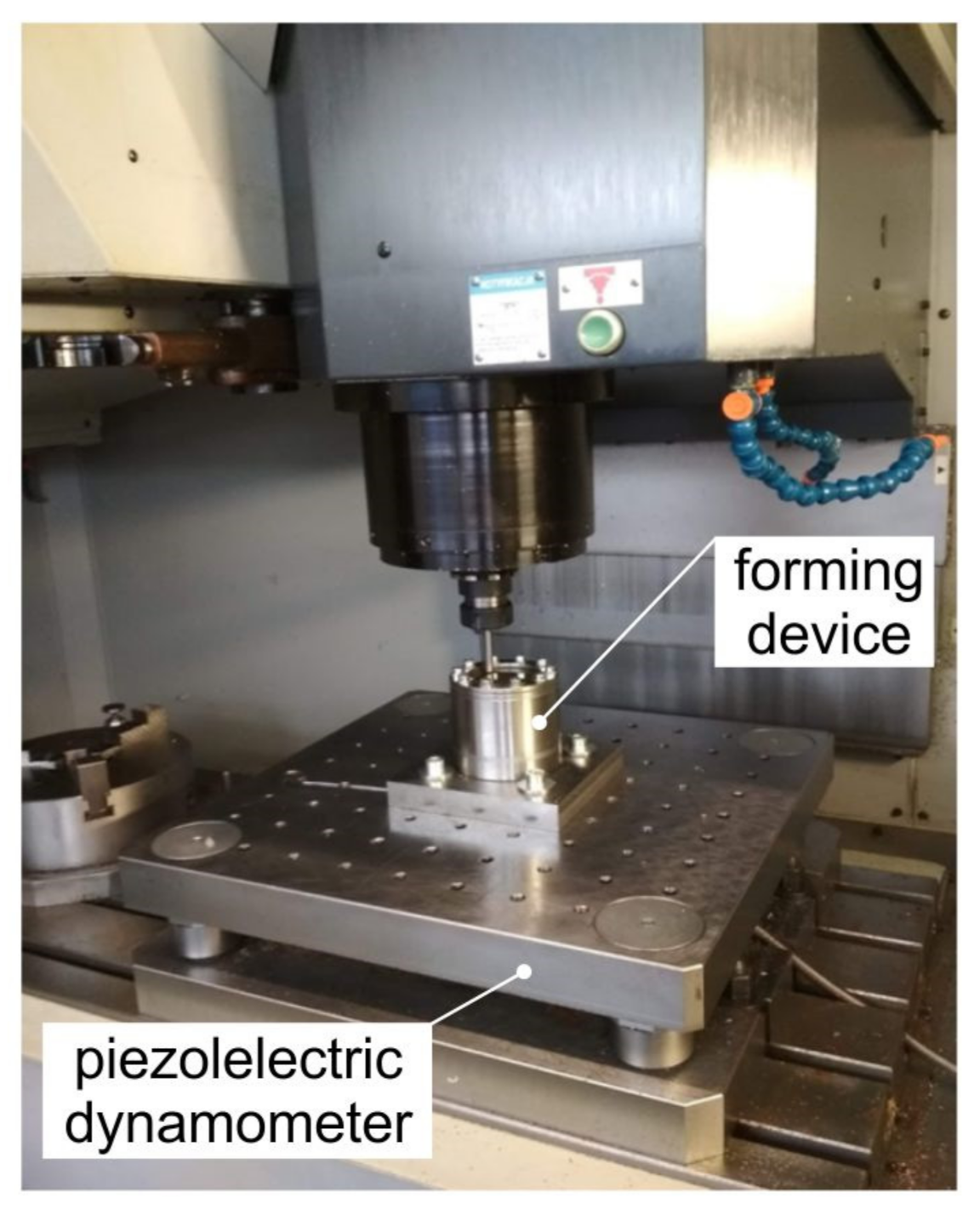


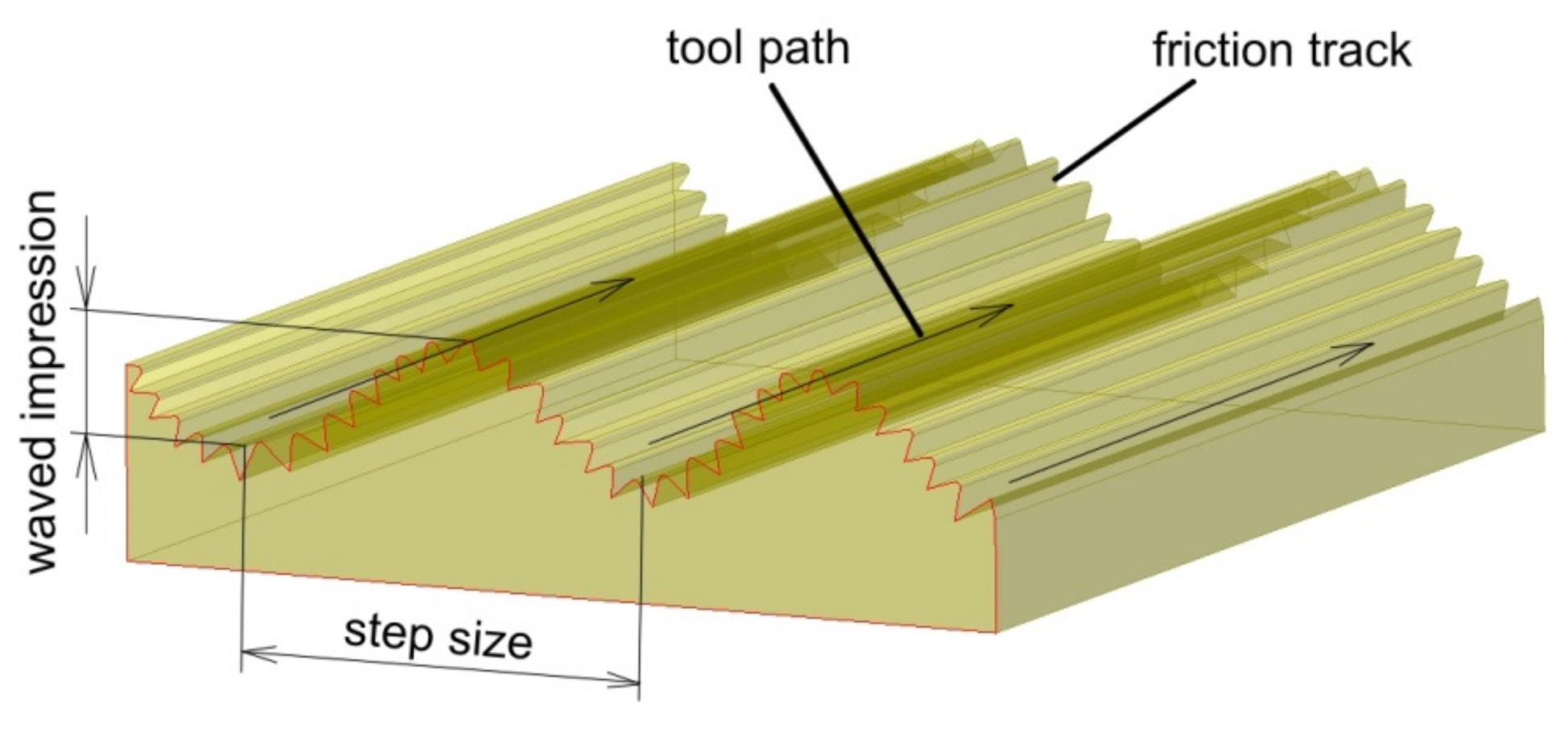
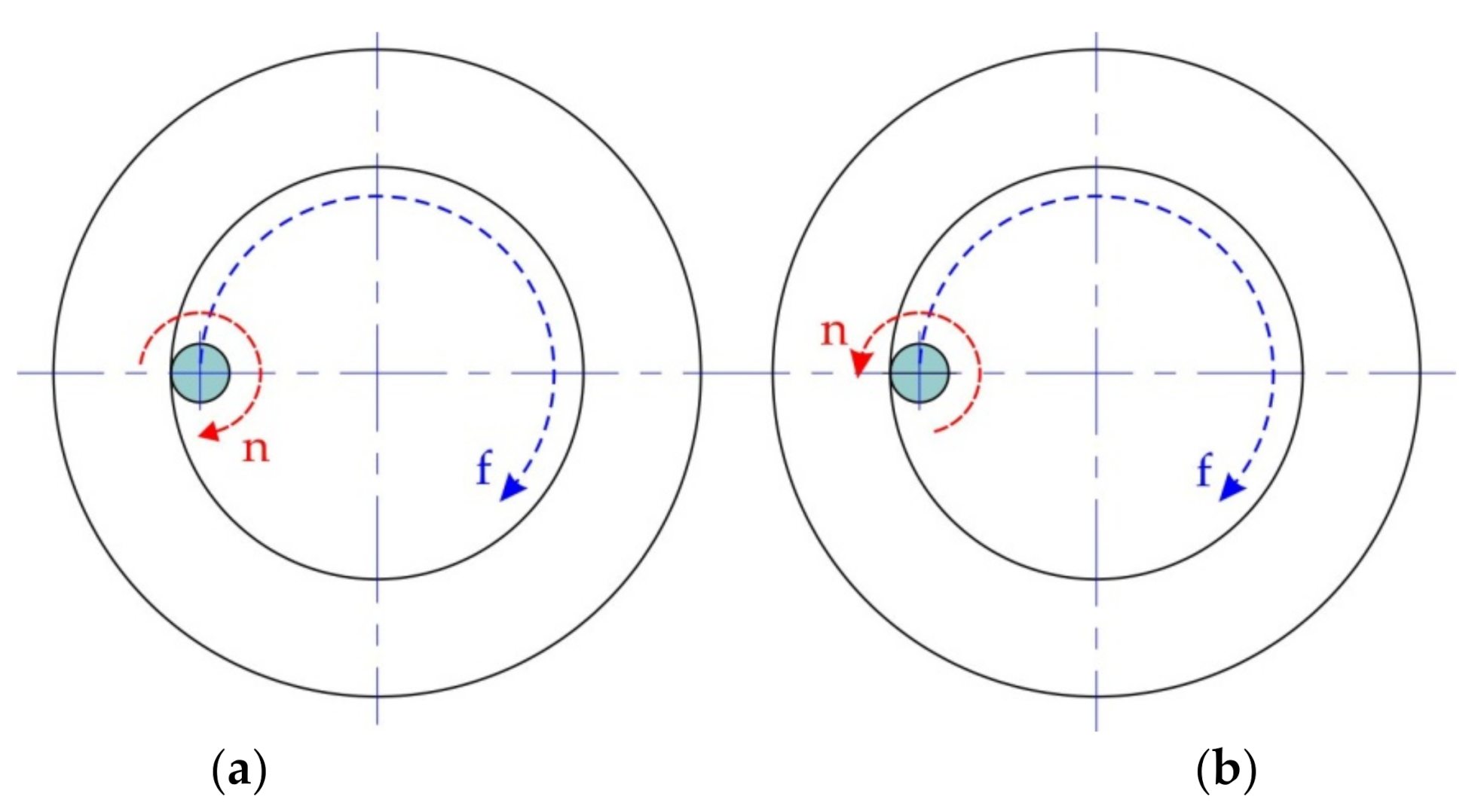
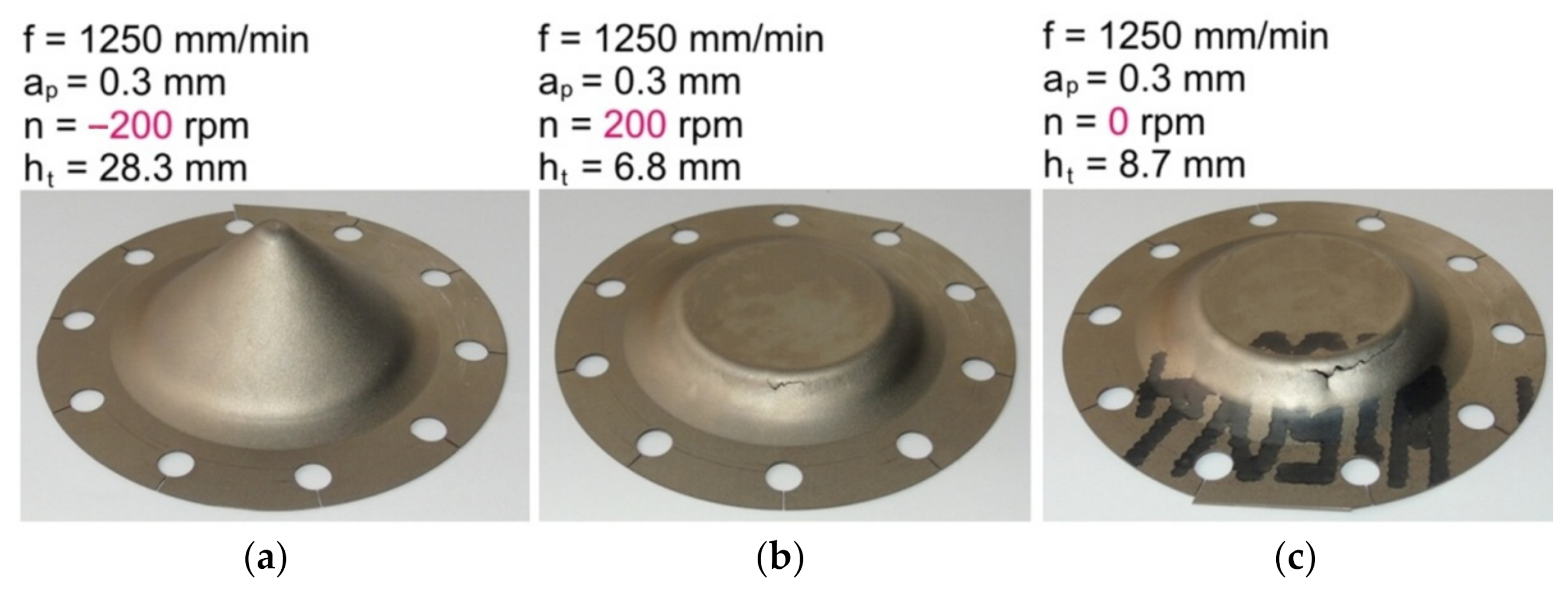
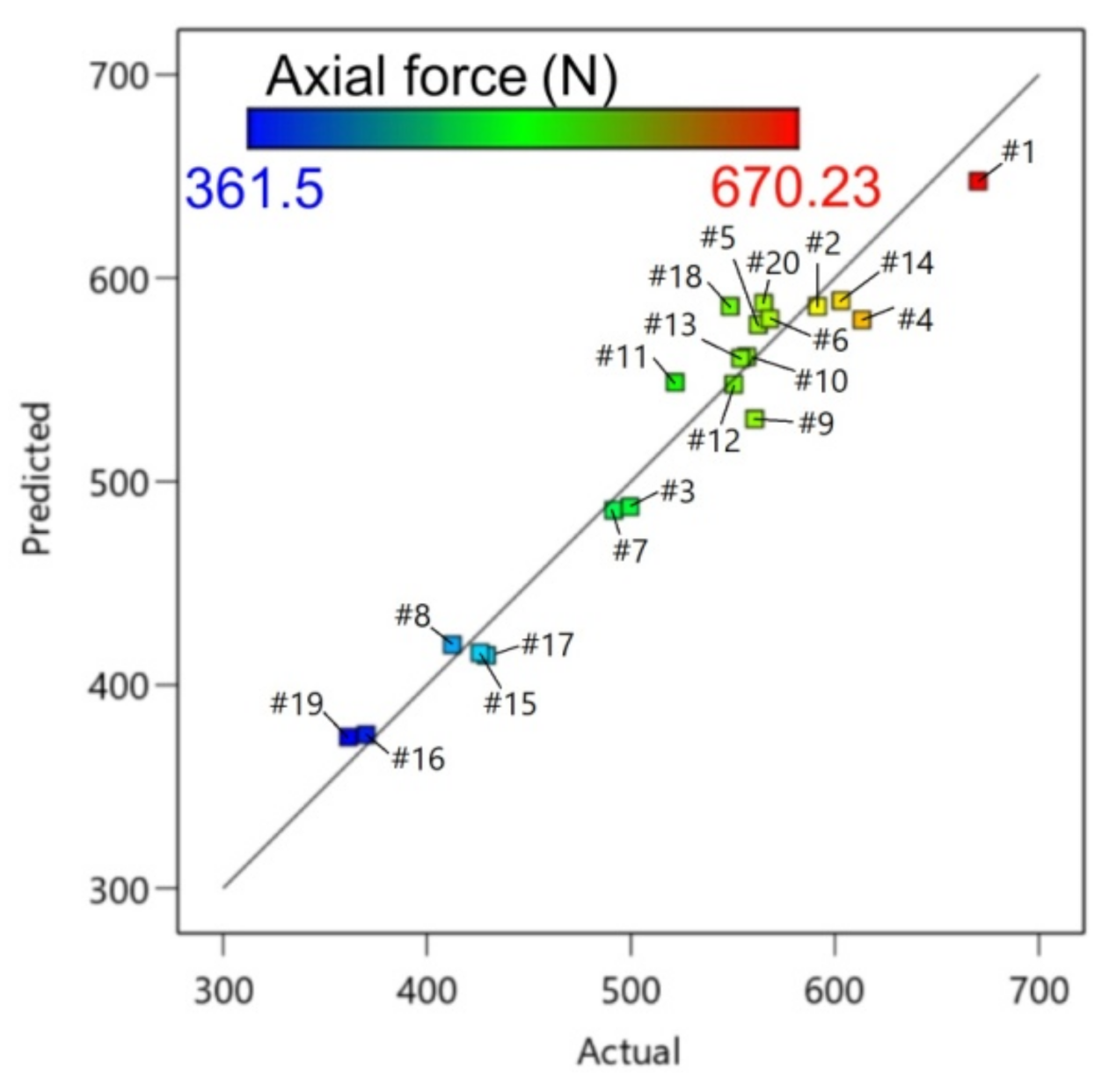
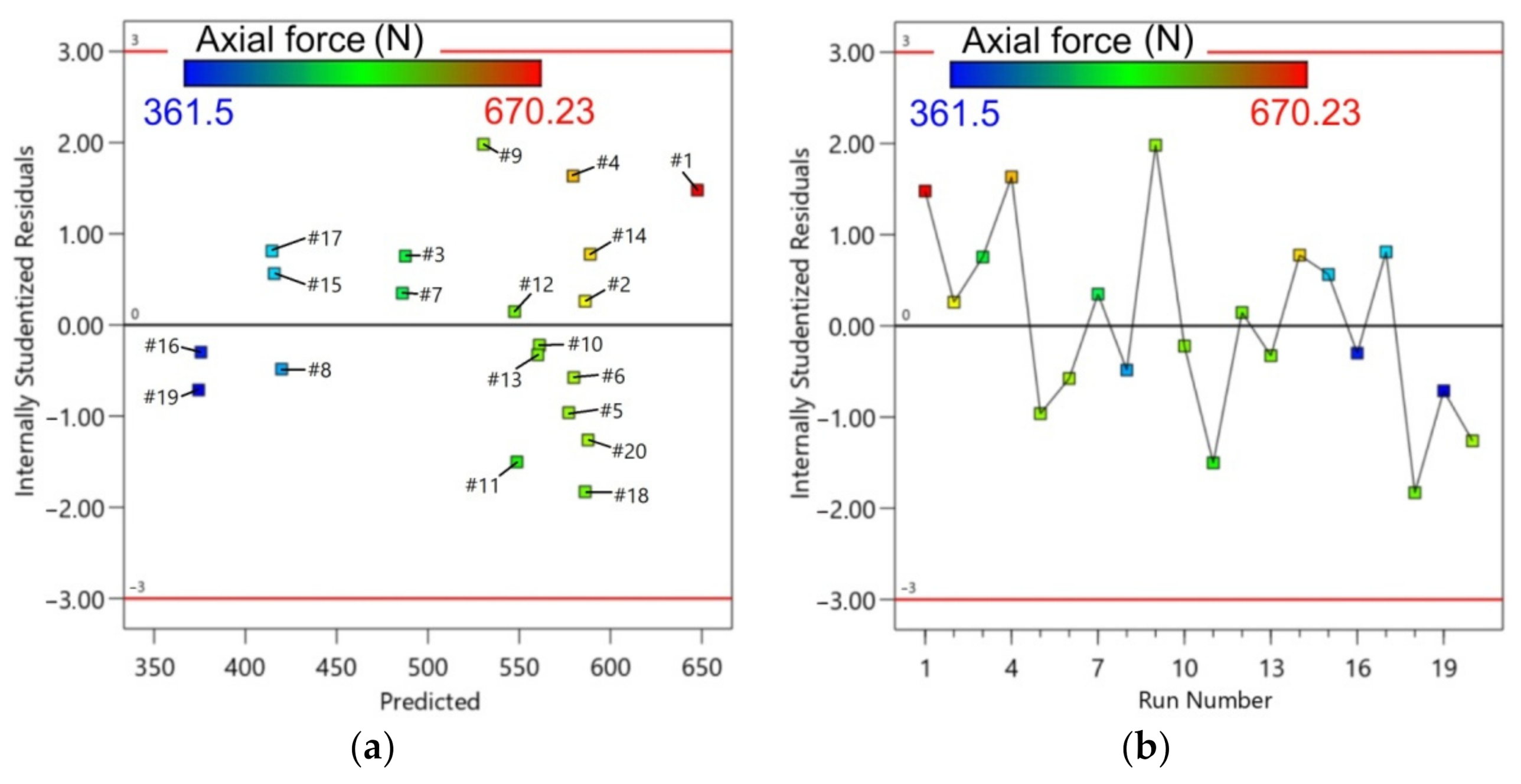
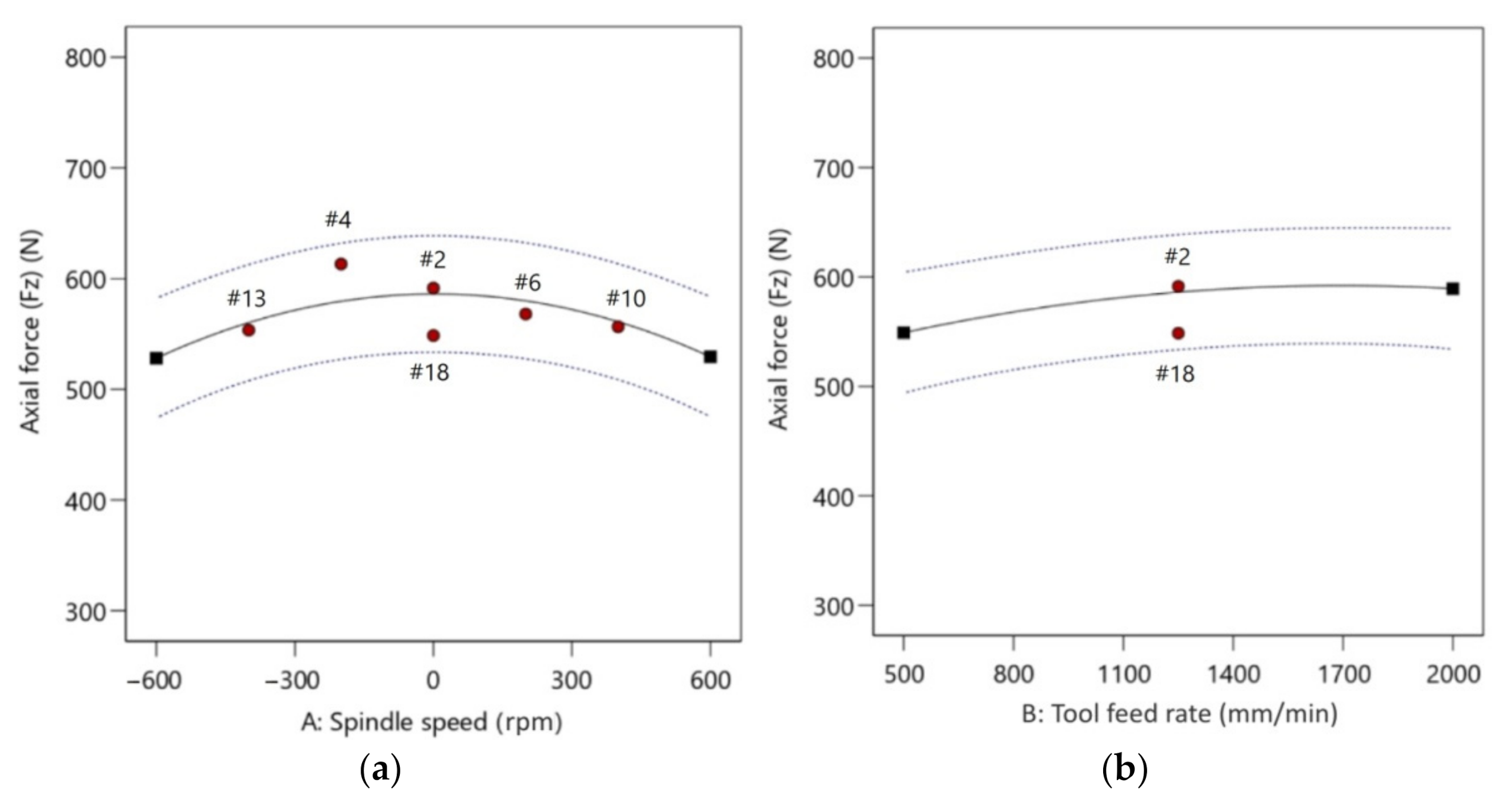


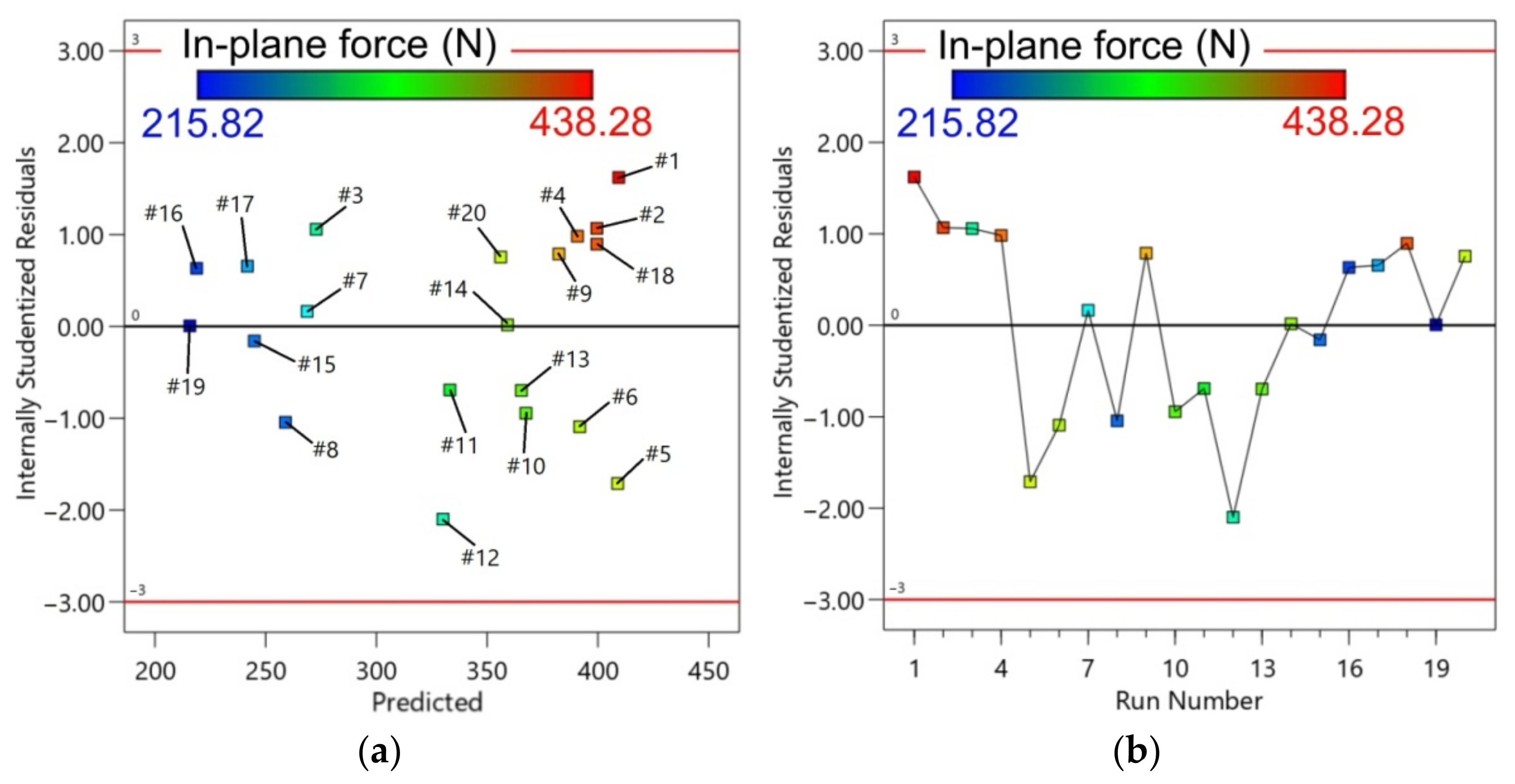

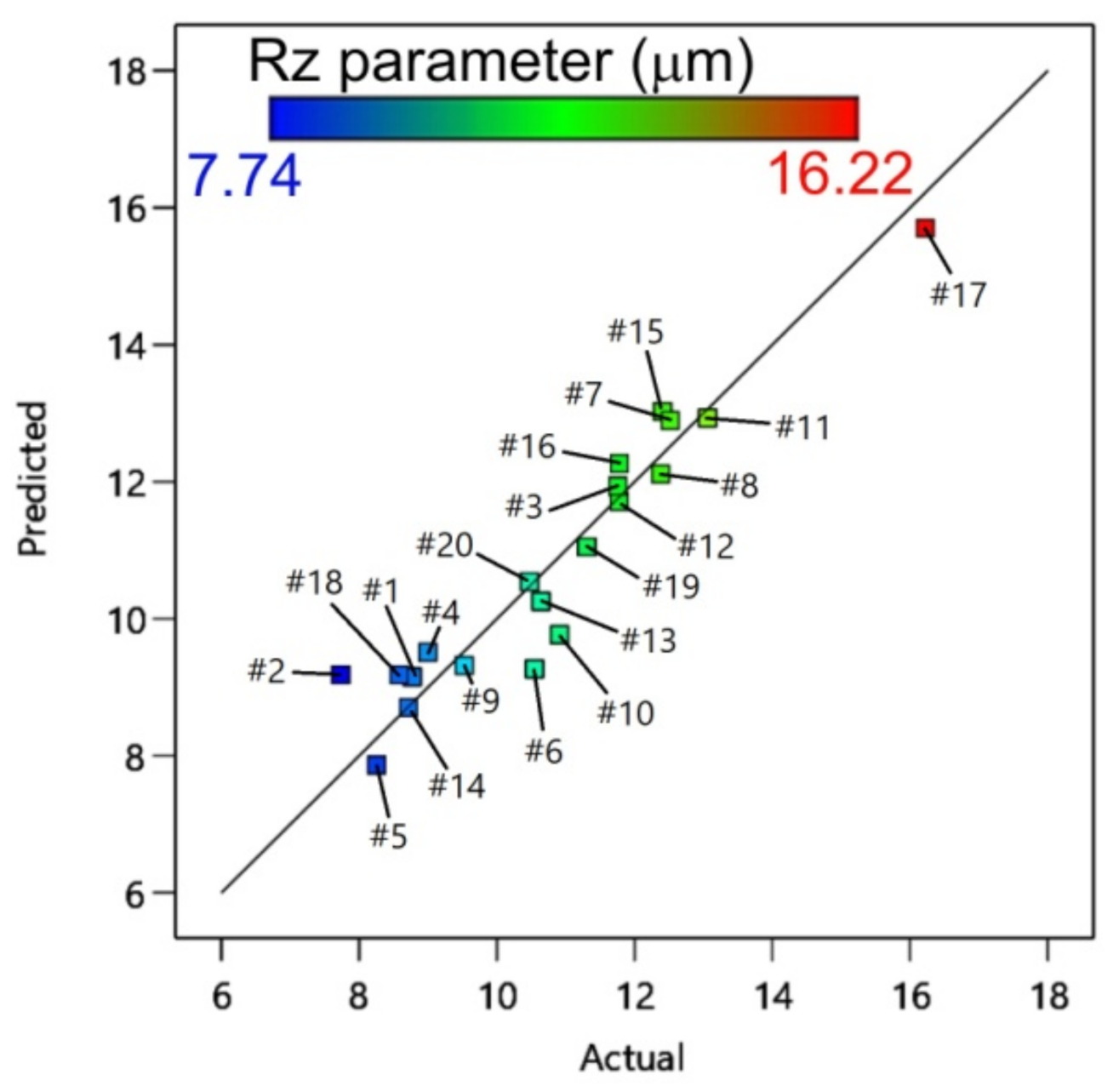

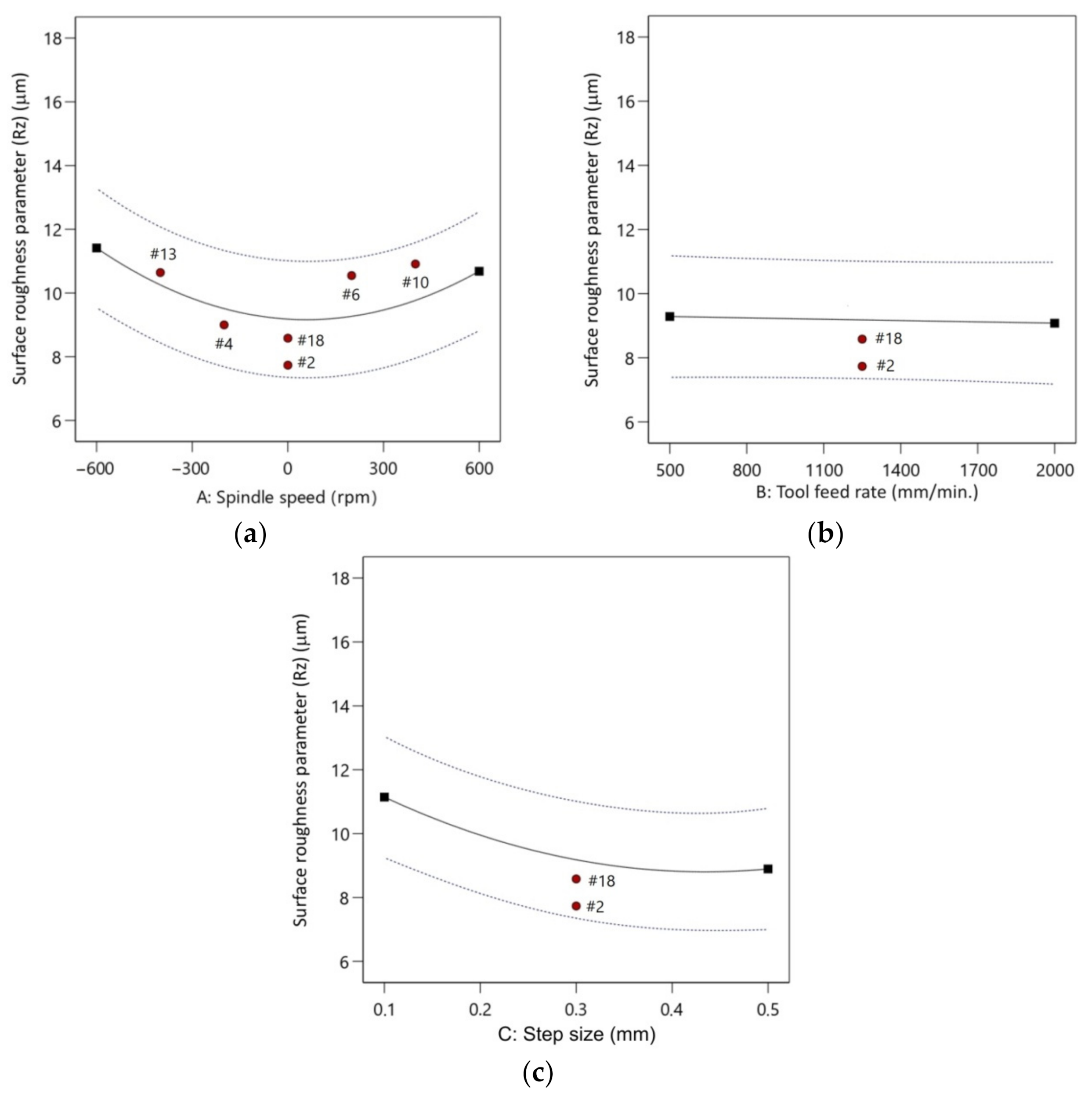
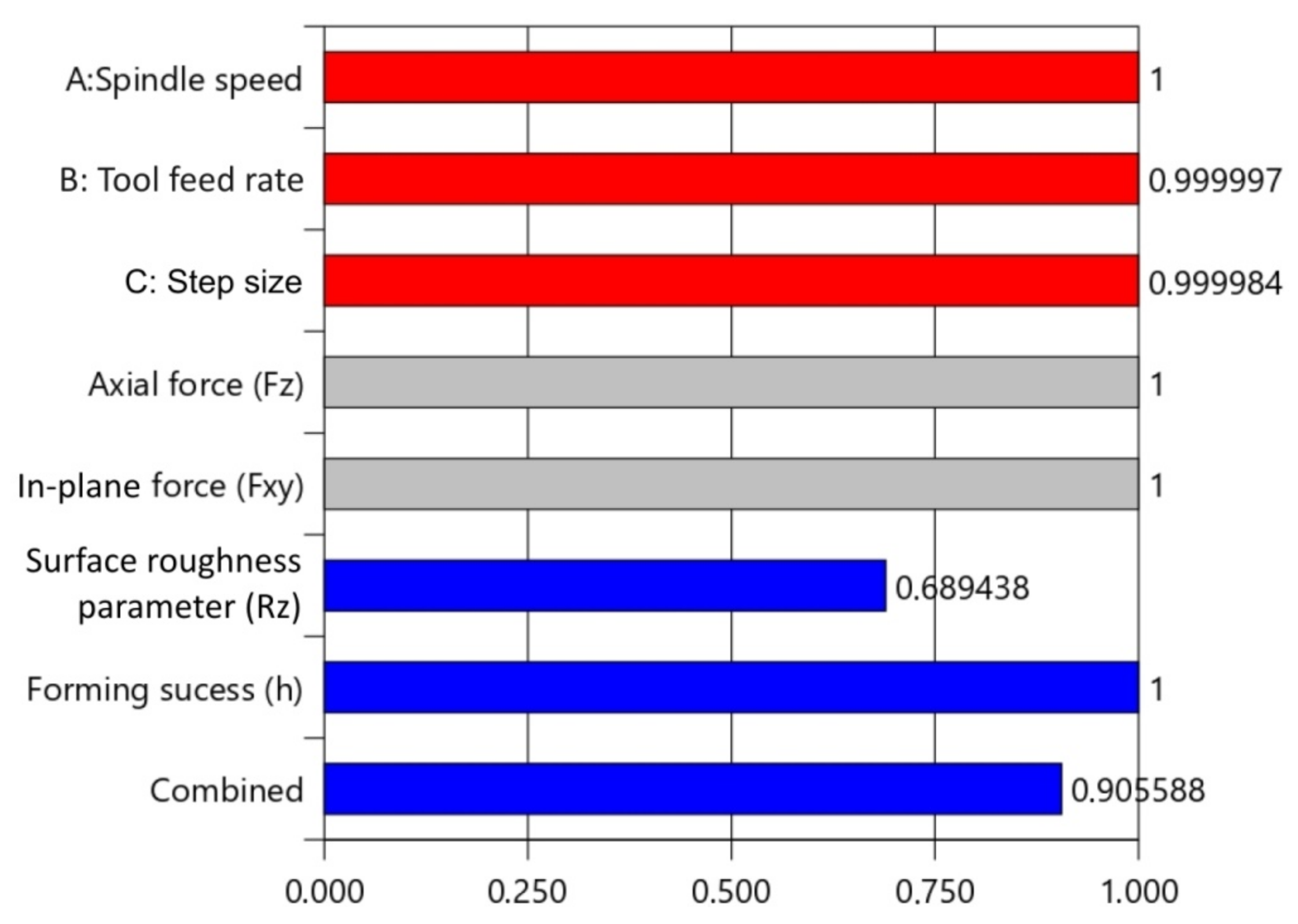

| Fe | C | O | N | Ti |
|---|---|---|---|---|
| 0.12 | 0.009 | 0.23 | 0.009 | balance |
| Forming Parameter | Factor | Unit | Low Level | High Level |
|---|---|---|---|---|
| Spindle speed n | A | rpm | −600 | 600 |
| Tool feed rate f | B | mm/min | 500 | 2000 |
| Step size ap | C | mm | 0.1 | 0.5 |
| Number of Experiment | Spindle Speed, rpm | Feed Rate, mm/min | Step Size, mm |
|---|---|---|---|
| 1 | 0 | 1250 | 0.563215 |
| 2 | 0 | 1250 | 0.3 |
| 3 | 789.644 | 1250 | 0.3 |
| 4 | −200 | 1250 | 0.3 |
| 5 | 200 | 2237.06 | 0.3 |
| 6 | 200 | 1250 | 0.3 |
| 7 | −789.644 | 1250 | 0.3 |
| 8 | 0 | 1250 | 0.0367852 |
| 9 | 0 | 262.944 | 0.3 |
| 10 | 400 | 1250 | 0.3 |
| 11 | 600 | 500 | 0.5 |
| 12 | −600 | 500 | 0.5 |
| 13 | −400 | 1250 | 0.3 |
| 14 | 600 | 2000 | 0.5 |
| 15 | 600 | 2000 | 0.1 |
| 16 | 600 | 500 | 0.1 |
| 17 | −600 | 2000 | 0.1 |
| 18 | 0 | 1250 | 0.3 |
| 19 | −600 | 500 | 0.1 |
| 20 | −600 | 2000 | 0.5 |
| Std. | Run | A: Spindle Speed, rpm | B: Feed Rate, mm/min | C: Step Size, mm | Axial Force Fz, N | In-Plane Force Fxy, N | Surface Parameter Rz, µm | Forming Success h, % |
|---|---|---|---|---|---|---|---|---|
| 14 | 1 | 0 | 1250 | 0.563215 | 670.23 | 438.28 | 8.772 | 27 |
| 15 | 2 | 0 | 1250 | 0.3 | 591.49 | 423.64 | 7.735 | 23.4 |
| 10 | 3 | 789.644 | 1250 | 0.3 | 499.63 | 292.15 | 11.757 | 100 |
| 19 | 4 | −200 | 1250 | 0.3 | 613.24 | 413.02 | 8.999 | 100 |
| 12 | 5 | 200 | 2237.06 | 0.3 | 562.4 | 373.59 | 8.718 | 27.9 |
| 16 | 6 | 200 | 1250 | 0.3 | 568.08 | 366.95 | 10.547 | 24 |
| 9 | 7 | −789.644 | 1250 | 0.3 | 491.62 | 271.71 | 12.518 | 100 |
| 13 | 8 | 0 | 1250 | 0.0367852 | 412.44 | 240.35 | 12.38 | 19.5 |
| 11 | 9 | 0 | 262.944 | 0.3 | 560.38 | 398.58 | 9.528 | 19.8 |
| 17 | 10 | 400 | 1250 | 0.3 | 556.51 | 345.96 | 10.91 | 100 |
| 6 | 11 | 600 | 500 | 0.5 | 521.73 | 319.57 | 13.06 | 100 |
| 5 | 12 | −600 | 500 | 0.5 | 550.16 | 288.34 | 11.777 | 100 |
| 18 | 13 | −400 | 1250 | 0.3 | 553.5 | 349.6 | 10.641 | 100 |
| 8 | 14 | 600 | 2000 | 0.5 | 603.06 | 359.52 | 8.253 | 100 |
| 4 | 15 | 600 | 2000 | 0.1 | 426.07 | 241.7 | 12.407 | 30.6 |
| 2 | 16 | 600 | 500 | 0.1 | 370.25 | 231.27 | 11.779 | 100 |
| 3 | 17 | −600 | 2000 | 0.1 | 429.13 | 254.68 | 16.22 | 100 |
| 20 | 18 | 0 | 1250 | 0.3 | 548.59 | 419.76 | 8.581 | 20.9 |
| 1 | 19 | −600 | 500 | 0.1 | 361.5 | 215.82 | 11.307 | 100 |
| 7 | 20 | −600 | 2000 | 0.5 | 565.1 | 371 | 10.475 | 100 |
| Source | Sum of Squares | Degrees of Freedom | Mean Square | F-Value | p-Value | Significance |
|---|---|---|---|---|---|---|
| Model | 1.259 × 105 | 6 | 20,984.00 | 41.38 | <0.0001 | significant |
| A-Spindle speed | 4.84 | 1 | 4.84 | 0.0095 | 0.9236 | – |
| B-Feed rate | 4626.49 | 1 | 4626.49 | 9.12 | 0.0098 | – |
| C-Step size | 85,902.91 | 1 | 85,902.91 | 169.38 | <0.0001 | – |
| A2 | 20,462.71 | 1 | 20,462.71 | 40.35 | <0.0001 | – |
| B2 | 2008.14 | 1 | 2008.14 | 3.96 | 0.0681 | – |
| C2 | 6495.64 | 1 | 6495.64 | 12.81 | 0.0034 | – |
| Residual | 6592.93 | 13 | 507.15 | – | – | – |
| LOF | 5672.72 | 12 | 472.73 | 0.5137 | 0.8118 | not significant |
| Pure Error | 920.20 | 1 | 920.20 | – | – | – |
| Cor Total | 1.325 × 105 | 19 | – | – | – | – |
| Std. Dev. | 22.52 | – | – | – | – | – |
| Mean | 522.76 | – | – | – | – | – |
| C.V. % | 4.31 | – | – | – | – | – |
| Source | Sum of Squares | Degrees of Freedom | Mean Square | F-Value | p-Value | Significance |
|---|---|---|---|---|---|---|
| Model | 89,185.94 | 5 | 17,837.19 | 29.83 | <0.0001 | significant |
| A-Spindle speed | 30.62 | 1 | 30.62 | 0.0512 | 0.8242 | – |
| B-Feed rate | 1938.55 | 1 | 1938.55 | 3.24 | 0.0933 | – |
| C-Step size | 37,474.84 | 1 | 37,474.84 | 62.68 | <0.0001 | – |
| A2 | 34,865.34 | 1 | 34,865.34 | 58.31 | <0.0001 | – |
| C2 | 10,453.82 | 1 | 10,453.82 | 17.48 | 0.0009 | – |
| Residual | 8370.66 | 14 | 597.90 | – | – | – |
| LOF | 8363.13 | 13 | 643.32 | 85.47 | 0.0845 | not significant |
| Pure Error | 7.53 | 1 | 7.53 | – | – | – |
| Cor. Total | 97,556.60 | 19 | – | – | – | – |
| Std. Dev. | 24.45 | – | – | – | – | – |
| Mean | 330.77 | – | – | – | – | – |
| C.V. % | 7.39 | – | – | – | – | – |
| Source | Sum of Squares | Degrees of Freedom | Mean Square | F-Value | p-Value | Significance |
|---|---|---|---|---|---|---|
| Model | 72.54 | 7 | 10.36 | 16.87 | <0.0001 | significant |
| A-Spindle speed | 1.68 | 1 | 1.68 | 2.73 | 0.1241 | – |
| B-Tool feed | 0.1219 | 1 | 0.1219 | 0.1985 | 0.6639 | – |
| C-Step size | 14.51 | 1 | 14.51 | 23.61 | 0.0004 | – |
| AB | 7.70 | 1 | 7.70 | 12.54 | 0.0041 | – |
| BC | 16.97 | 1 | 16.97 | 27.61 | 0.0002 | – |
| A2 | 21.96 | 1 | 21.96 | 35.75 | <0.0001 | – |
| C2 | 5.14 | 1 | 5.14 | 8.37 | 0.0135 | – |
| Residual | 7.37 | 12 | 0.6144 | – | – | – |
| LOF | 7.01 | 11 | 0.6377 | 1.78 | 0.5305 | not significant |
| Pure Error | 0.3579 | 1 | 0.3579 | – | – | – |
| Cor. Total | 79.92 | 19 | – | – | – | – |
| Std. Dev. | 0.7838 | – | – | – | – | – |
| Mean | 10.82 | – | – | – | – | – |
| C.V. % | 7.25 | – | – | – | – | – |
| Constraints Name | Goal | Lower Limit | Upper Limit |
|---|---|---|---|
| A: Spindle speed | is in range | −600 | 600 |
| B: Feed rate | maximise | 500 | 2000 |
| C: Step size | maximise | 0.1 | 0.5 |
| Axial force (Fz) | none | 361.5 | 670.23 |
| In-plane force (Fxy) | none | 215.82 | 438.28 |
| Surface roughness parameter (Rz) | minimise | 7.735 | 16.22 |
| Forming success (h) | maximise | 95 | 100 |
| Spindle Speed, rpm | Tool Feed, mm/min | Step Size, mm | Axial Force Fz, N | In-Plane Force Fxy, N | Surface Roughness Parameter Rz, μm | Forming Success (h) | Desirability D |
|---|---|---|---|---|---|---|---|
| −579.844 | 2000 | 0.500 | 591.518 | 361.058 | 10.370 | 100.00 | 0.906 |
Publisher’s Note: MDPI stays neutral with regard to jurisdictional claims in published maps and institutional affiliations. |
© 2021 by the authors. Licensee MDPI, Basel, Switzerland. This article is an open access article distributed under the terms and conditions of the Creative Commons Attribution (CC BY) license (https://creativecommons.org/licenses/by/4.0/).
Share and Cite
Szpunar, M.; Ostrowski, R.; Trzepieciński, T.; Kaščák, Ľ. Central Composite Design Optimisation in Single Point Incremental Forming of Truncated Cones from Commercially Pure Titanium Grade 2 Sheet Metals. Materials 2021, 14, 3634. https://doi.org/10.3390/ma14133634
Szpunar M, Ostrowski R, Trzepieciński T, Kaščák Ľ. Central Composite Design Optimisation in Single Point Incremental Forming of Truncated Cones from Commercially Pure Titanium Grade 2 Sheet Metals. Materials. 2021; 14(13):3634. https://doi.org/10.3390/ma14133634
Chicago/Turabian StyleSzpunar, Marcin, Robert Ostrowski, Tomasz Trzepieciński, and Ľuboš Kaščák. 2021. "Central Composite Design Optimisation in Single Point Incremental Forming of Truncated Cones from Commercially Pure Titanium Grade 2 Sheet Metals" Materials 14, no. 13: 3634. https://doi.org/10.3390/ma14133634
APA StyleSzpunar, M., Ostrowski, R., Trzepieciński, T., & Kaščák, Ľ. (2021). Central Composite Design Optimisation in Single Point Incremental Forming of Truncated Cones from Commercially Pure Titanium Grade 2 Sheet Metals. Materials, 14(13), 3634. https://doi.org/10.3390/ma14133634









